Report

At a Glance
- After a strong post–Covid-19 recovery in the first quarter of 2021, China’s FMCG sales declined to negative .8% growth by the third quarter, the result of mounting macroeconomic pressures.
- Still, the fundamentals for sustained growth exist in food, beverages, home care, and personal care. Similar to previous reports, we see winners and losers in categories, channels, and platforms.
- Of these 46 insurgent brands we began tracking in 2018, we were surprised to see that only 17 continued to do well, while the others faded away or plateaued.
- We now see it comes down to excellence in four areas: brand power, product ecosystem, channel capability, and organization capability. We have assembled a Class of 2021: 69 insurgent brands that we are tracking for future lessons.
Executive summary
The massive decline in China’s FMCG spending brought on by the Covid-19 pandemic in the first half of 2020 ended with an equally dramatic rebound in the second half of 2020. That spending resurgence continued unabated into the first quarter of 2021. But the third quarter brought with it an abrupt slowdown, with overall growth dropping to negative .8% compared with the same period last year, leaving many surprised (see Figure 1). Digging deeper, we found there are clear reasons for the lackluster third-quarter performance.
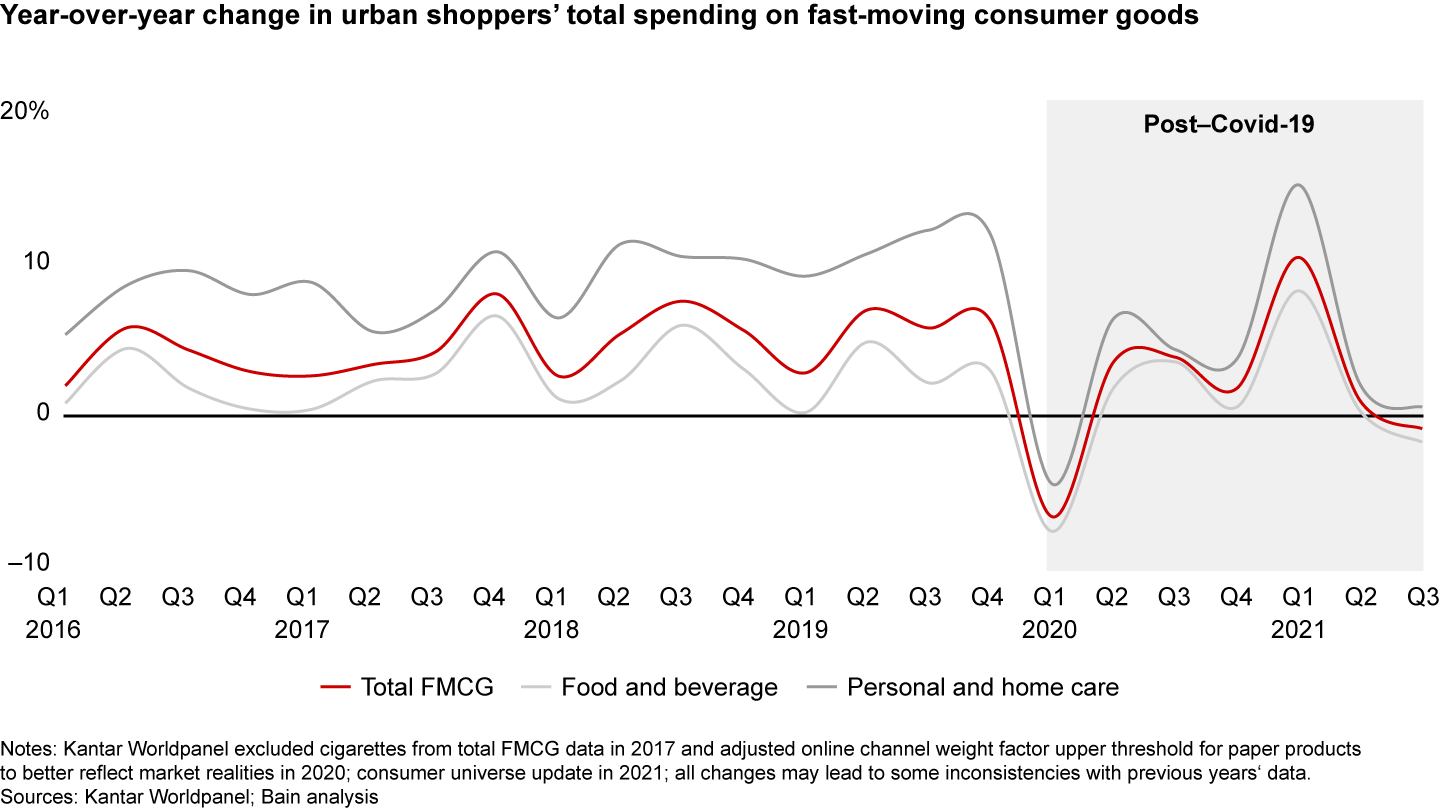
Covid-19 cases climbed in some cities. Typhoons and floods ravaged some regions. These events kept consumers at home and purchases deferred. Meanwhile, depressed stock markets and a soft market for property sales and construction starts resulted in lost jobs and dwindling consumer confidence. On the supply side, brands and platforms reduced their activation and promotion investments, while power shortages in multiple provinces designed to meet carbon neutrality policy hurt productivity.
Written in collaboration with
Written in collaboration with

Despite the stalled third-quarter growth, strong fundamentals of consumption are still in place. For example, China’s middle class continues to expand its ranks and repatriation—driven by Covid-19-related travel restrictions—is contributing to a steady growth. Following years of 5% growth, until 2019 and a flat 2020, FMCG volume gained 3.3% and value rose 3.6% in the first nine months of 2021 for a modest post–Covid-19 recovery, even if average selling prices (ASP) remained depressed, gaining only .3%. Even at that low rate of growth, it seems that ASP is narrowing its gap with China’s inflation rate vs. 2020, but we need to take into account that the consumer price index is likely understated, given its dependence on fresh products such as pork, which has seen declining prices in the second half of 2021 (see Figure 2).
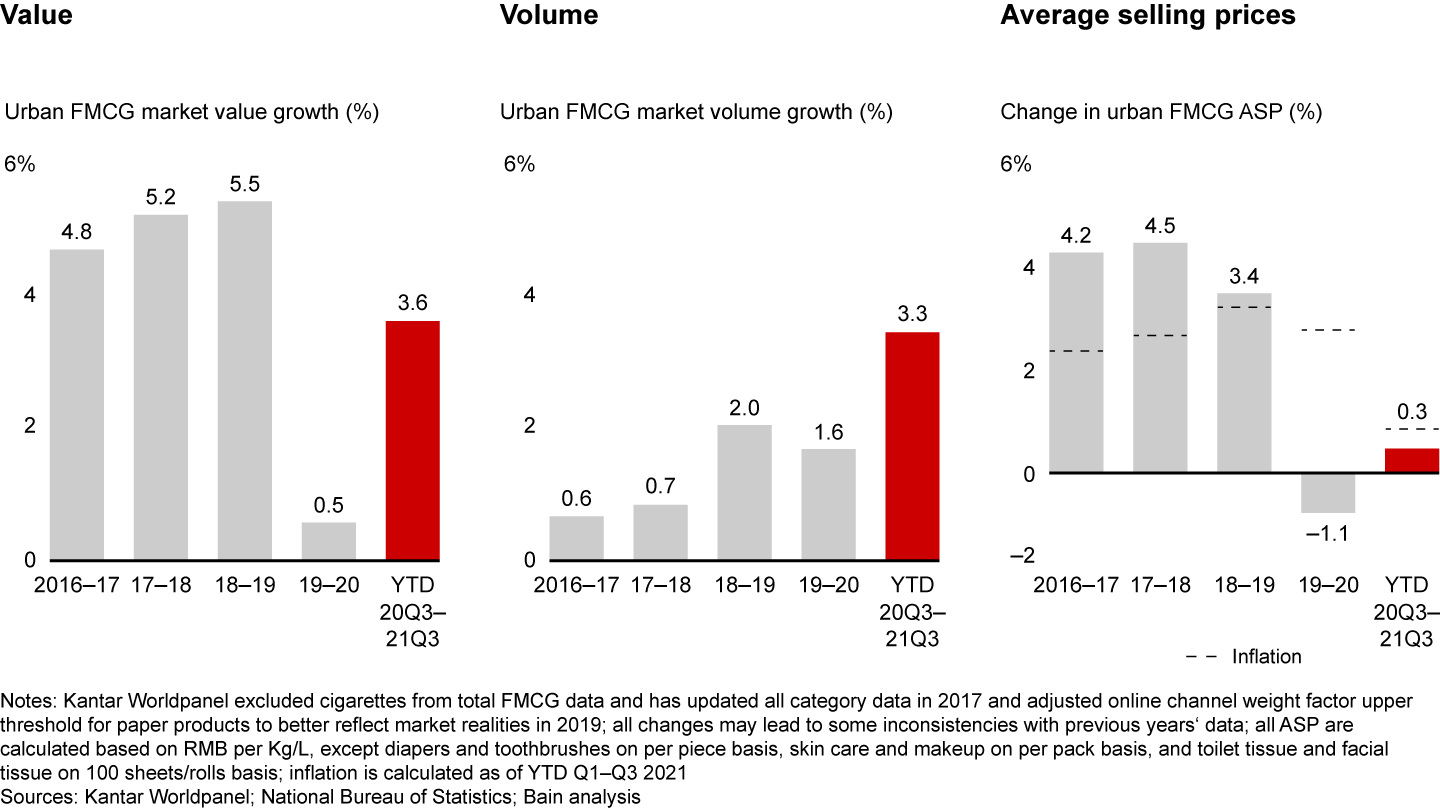
This is the tenth consecutive year that we have tracked the shopping behaviors of Chinese consumers. Our continuing research has given us a valuable long-term view across 106 fast-moving consumer goods (FMCG) categories purchased for home consumption in China. As in each of the past nine years, we analyzed the 26 key categories1 that span the four largest consumer goods sectors: packaged food, beverages, personal care, and home care. This report, which updates the findings from China Shopper Report 2021, Vol. 1, Inside China’s Subtle FMCG Recovery, includes Kantar Worldpanel shopper behavior data for the first three quarters of 2021.
This year we also added a new dimension to our research, a deep dive into the factors that contribute to the success or failure of the insurgent brands that are rewriting the rules in FMCG. We evaluated the performance of the 46 local insurgent brands we first identified in China Shopper Report 2018, Vol. 2, Local Insurgents Shake up China’s Two-Speed Market. Our findings gave us a clear view of the reasons that some insurgent brands significantly outperform their product categories—and in record time—while others wither and disappear equally quickly. We detail the results of our research in this report. Based on our important findings and considering the rapid evolution of the FMCG market, we have assembled a “Class of 2021” comprising 69 insurgent brands that we will track over the years ahead for deep analysis.
Different categories, different trajectories
Personal care and home care continued to grow along with a volume recovery. In personal care categories, a 3.8% volume growth and 2.1% gain in ASP led to 5.9% value growth for the first nine months of 2021, a substantial improvement from 1.1% value growth for the same period last year (see Figure 3). Behind the performance there was a return to out-of-home activities that resulted in higher sales in makeup, shampoo, and hair conditioner, among other categories.
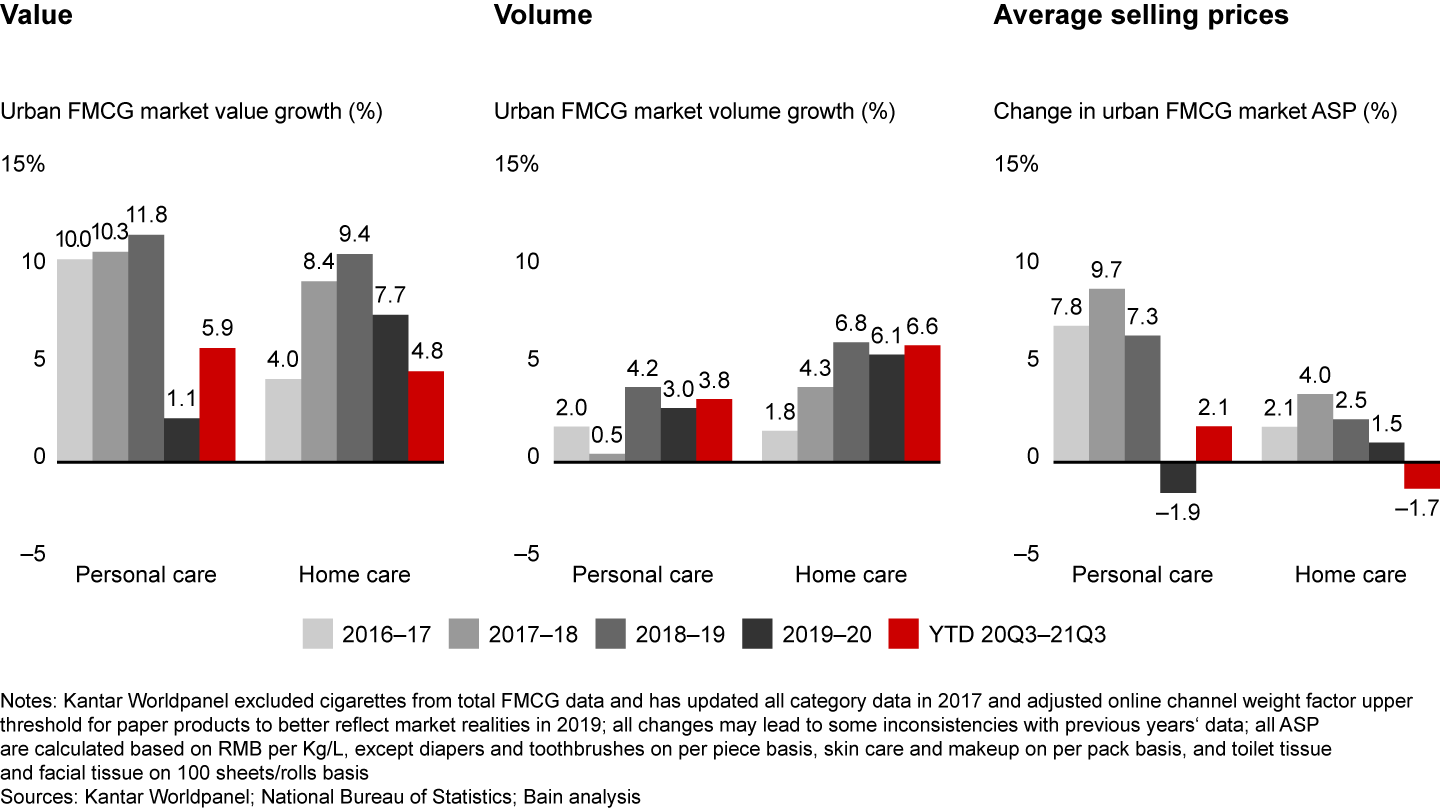
The story wasn’t as positive for home-care categories. Volume rose by a healthy 6.6%, as the resumption of out-of-home activities boosted demand for everything from fabric softener to facial tissue. But heavy discounts and promotions in mass categories such as laundry detergent and kitchen cleaner hurt ASP, which dropped by 1.7%. Those lower prices offset volume gains to deliver 4.8% value growth—far below the 7.7% value growth in the first nine months of 2020.
Last year we reported about the extensive hoarding that took place during the height of the Covid-19 pandemic, as locked-down and anxious consumers stocked up on many packaged food categories, such as instant noodles, biscuits, and infant milk formula. That hoarding has come back to haunt those categories in 2021. Overall volume in packaged food dropped by 3.7% while ASP rose by 1.5%, resulting in a 2.3% decline in value (see Figure 4). One thing that helped keep ASP above inflation: Brands introduced smaller pack sizes at a higher price/kg and added health-related words to packaging, which enabled them to charge premium prices.
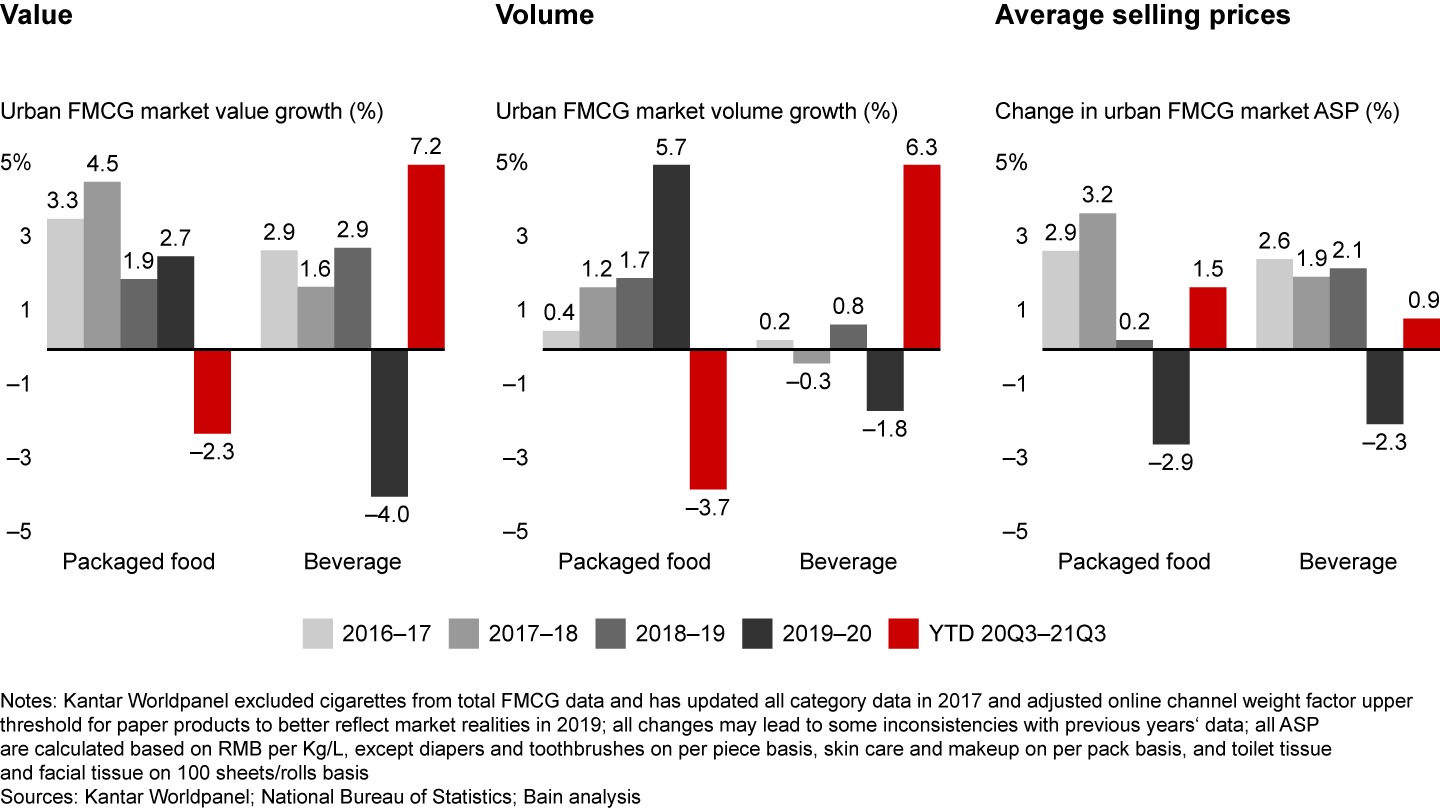
The story was much better in beverage categories, which saw a 6.3% rise in volume and .9% ASP gain for a value increase of 7.2% in the first three quarters of 2021. As consumers resumed hosting at-home gatherings, they bought more beverages. They also continued to increase their purchases of products that offer the promise of improved health. For example, during the pandemic, many households stocked up on bottled water, which they viewed as being healthier than tap water. As the pandemic eased, they maintained their preference for bottled water.
Five years ago, we noticed a distinctive trend in Chinese FMCG performance. We found that some categories were declining by double digits, while at the same time, some categories were actually growing by double digits. This two-speed growth has continued each year, to the point that the two trajectories are more polarized than ever. At the fast-growth end of the spectrum, mouthwash, a product associated with health, grew by a robust 33% in the first three quarters of 2021 compared with the same period a year earlier (see Figure 5). On the low-growth end, we found that disinfectants, a product category used heavily during the height of the Covid-19 pandemic, saw growth fall by 28%, as many consumers returned to pre-pandemic behaviors. In general, categories associated with improved quality of life, such as cheese, air refresher, and ready-to-drink coffee, grew at high speeds while categories popular during the lockdown months, such as instant noodles, biscuits, and hand wash, experienced negative growth.
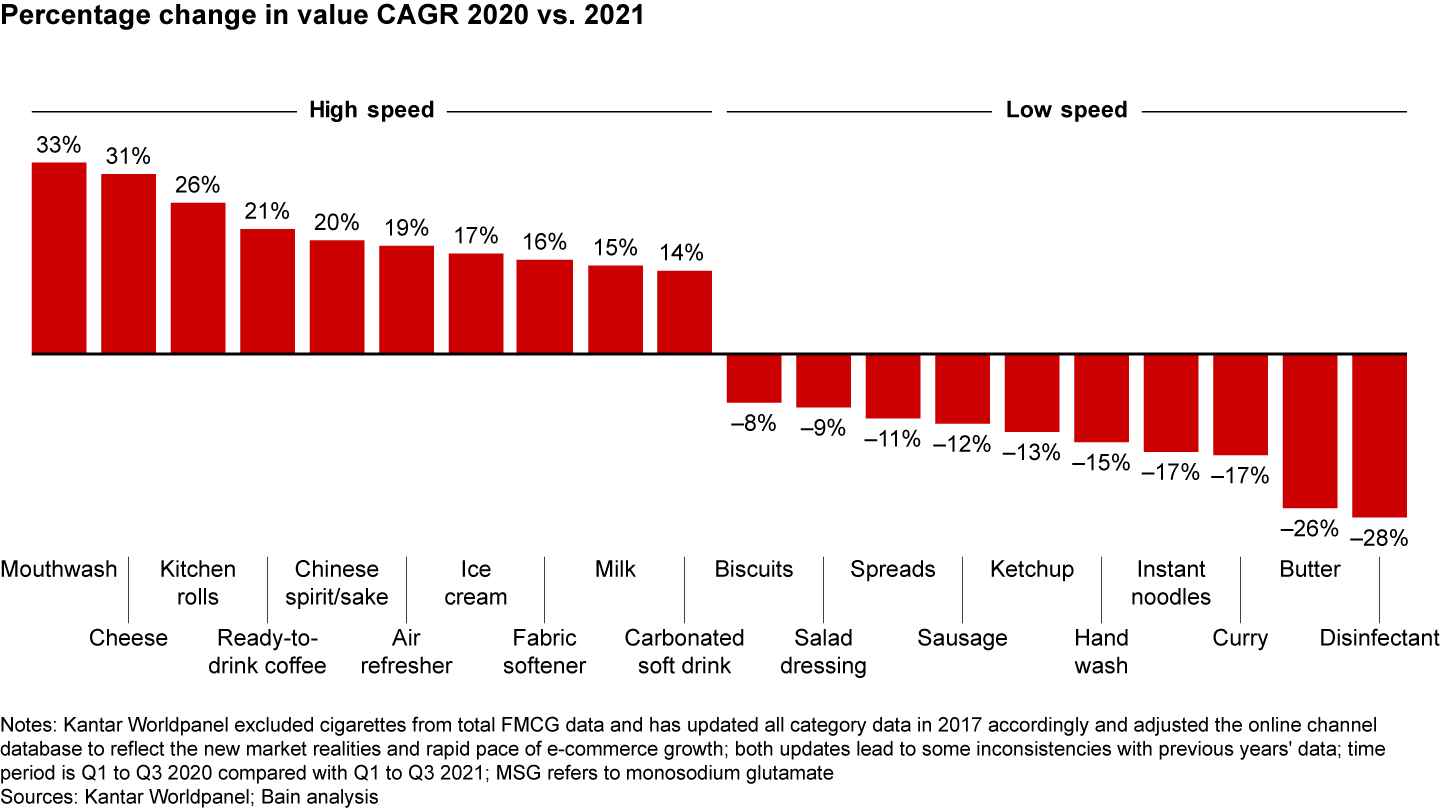
Changing channels
The channel shifts that have been shaping China shopper behavior accelerated in the first three quarters of 2021, with penetration increasing in online channels at the expense of most offline channels. E-commerce value grew 24%—less than last year’s 32%—while all offline channels except convenience stores lost value (the grocery channel by 13%). For its part, the performance of convenience stores remained flat—neither gaining nor losing value (see Figure 6).
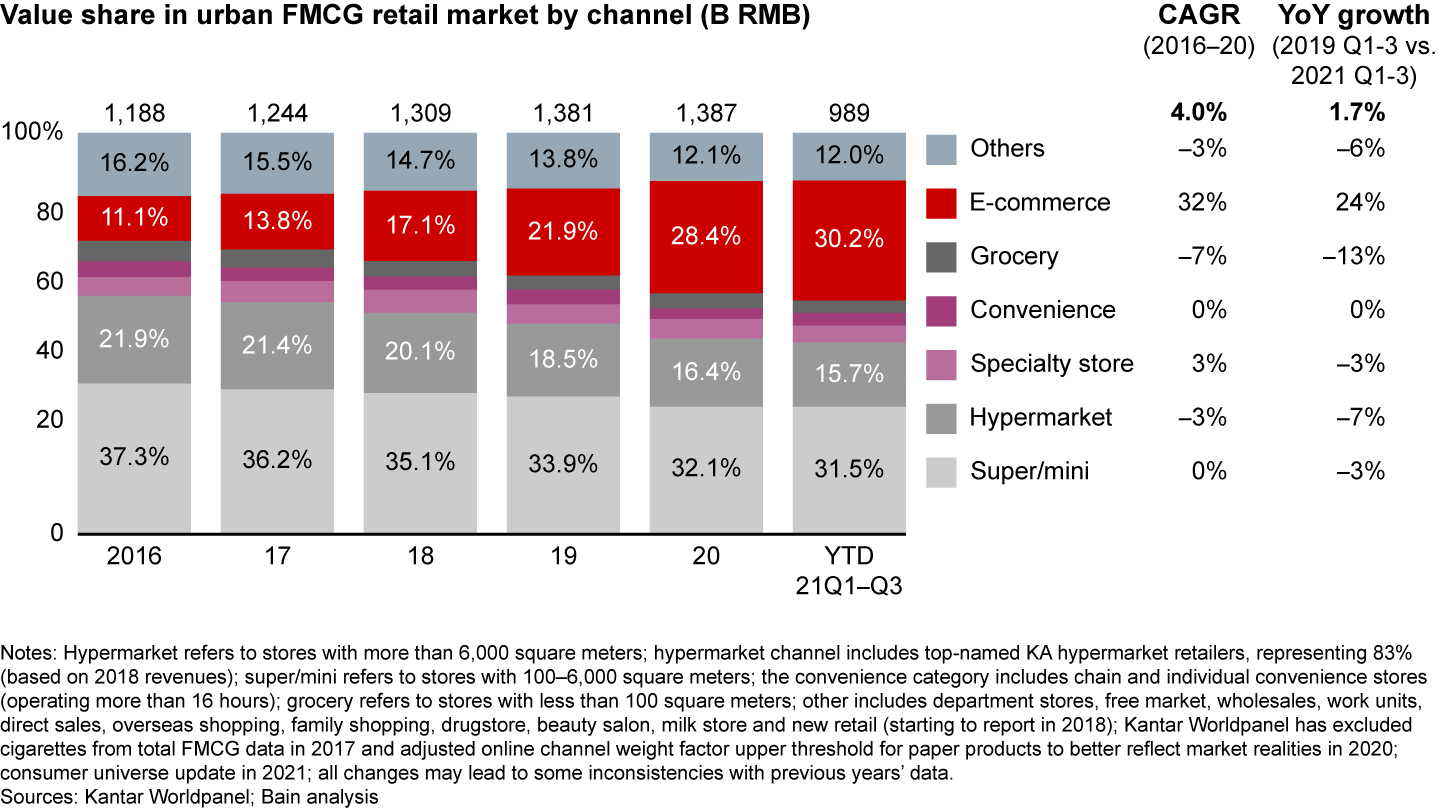
However, within online channels, the share of growth has been steadily changing over the past three years. A game that was once mostly limited to two main players is rapidly expanding to include a host of new competitors. In 2020, Alibaba contributed 49% of the e-commerce channel’s growth. This year that has dropped to 35% as the field expands with Pinduoduo, Douyin, Kuaishou, Xiaohongshu, WeChat, and others gaining sales from established platforms.
Channel changes were evident in livestreaming, too. Virtually unknown before bursting onto the retailing scene in 2019, livestreaming provides immersive experiences for consumers and personalized recommendations from key opinion leaders (KOL) and other hosts. As the country locked down during the Covid-19 pandemic, livestreaming offered an entertaining alternative to physical shopping trips. There are both KOL-led and brand-led versions of livestreaming.
While livestreaming introduced a new way to sell goods to consumers and encouraged impulse shopping, brands discovered the KOL version came with challenges. For example, goods promoted by KOLs are usually sold at deep discounts and require commissions as high as 30% as well as a listing fee to advertise. Moreover, by selling on a KOL’s livestream, brands lack full access to the consumer data that has become critical for retargeting and retention. For some brands, KOL livestreaming only provides a temporary sales improvement.
These drawbacks led brands to aggressively start their own livestreaming. Self-livestreaming positions the brand to retain consumers for repurchase, and it enables the timely consumer interaction and support that can improve loyalty and the possibility of lowering the rate of refunds. Brands are now taking share from KOLs, although many of those KOLs remain popular.
Consumers like livestreaming’s convenience, which is also a big part of the appeal of O2O (online to offline) retailing, a phenomenon that boomed during the pandemic. O2O accounts for 7% of all FMCG value and its penetration among consumers remains above 50% for FMCG categories (see Figure 7). While consumers turn to livestreaming for categories like makeup and apparel, they use O2O channels for products that are cheaper, handy, and require less emotional involvement. Think toilet tissue, facial tissue, and packaged water. These are products that consumers run out of and quickly order for one-hour delivery. As Covid-19’s effect on purchasing behavior lessened, O2O penetration remained flat and the share of value from O2O slightly declined.
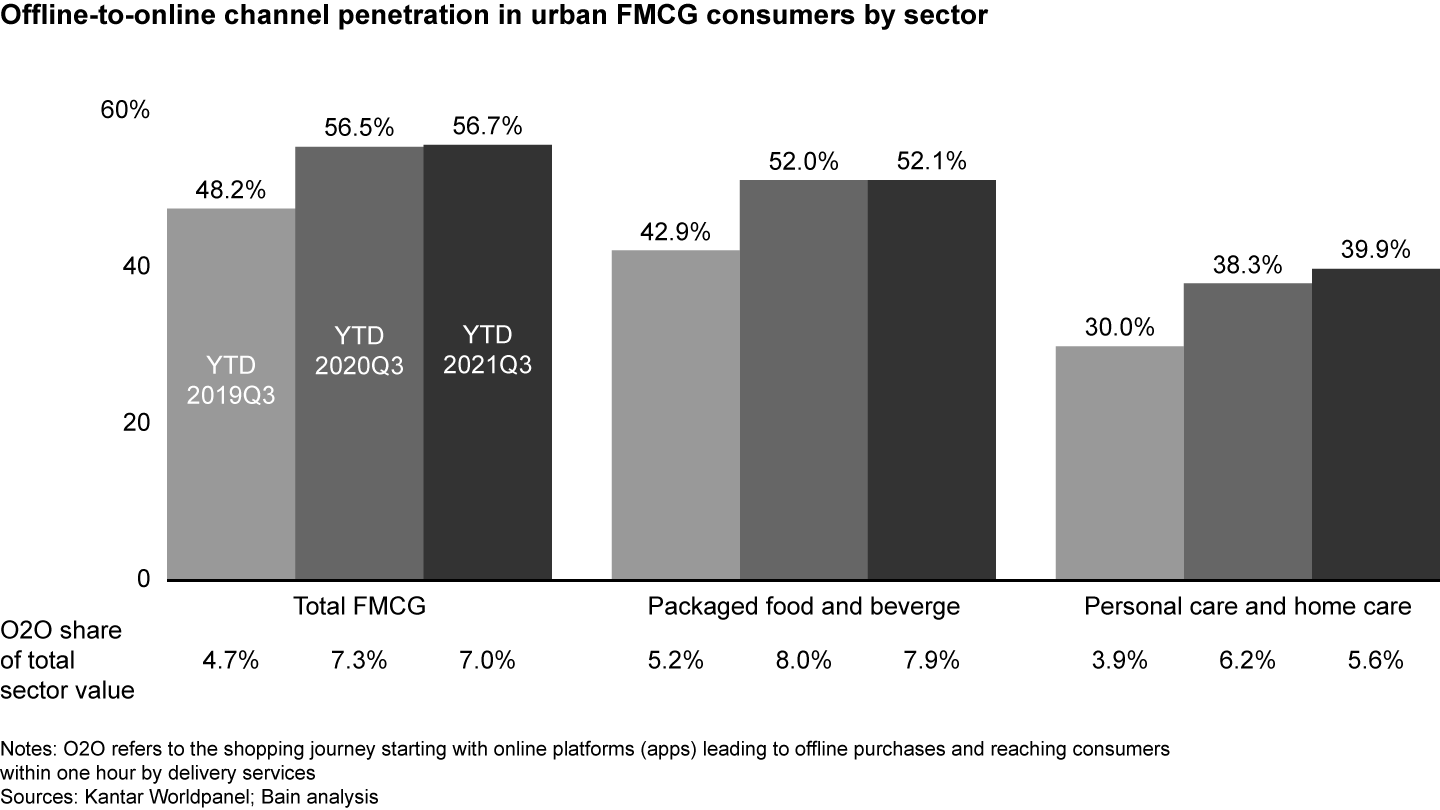
However, different O2O platforms experienced different fates. There are four types of O2O platforms.
- Horizontal marketplaces, such as Eleme, JD Daojia, and Meituan, that serve retailers and brands and have O2O distribution capabilities.
- Offline retailers offering O2O services via self-owned or third-party delivery capabilities, such as RT-Mart, Walmart, and Freshippo.
- Vertical grocery e-commerce apps with self-owned dark stores and delivery capabilities, such as Dingdong Maicai and Missfresh.
- Community-based group buy platforms with community captains that source directly while coordinating orders, delivery, and managing offline pickup points. Among the players are Meituan Maicai, Duo Duo Maicai, and Xingsheng Youxuan.
Horizontal marketplaces may be the major source of O2O traffic, but it was the vertical grocery apps, with their focus on fresh food, that enjoyed the fastest growth in 2021.
Community group buying’s popularity rose during the earliest months of the pandemic and became so important in the first quarter of 2021 that all major platforms invested heavily in it to stay connected to consumers. But the trend began to wane as its economics came into sharper focus. The total value of goods sold via this channel totaled RMB 54.8 billion in the second quarter of 2020 (see Figure 8). By the third quarter of 2021, it dropped to RMB 48.3 billion. Initially developed as a way to reach consumers in China’s Tier 2–5 cities and across the countryside, its early success was built on subsidies and heavy promotions aimed at establishing and growing penetration at any cost. For example, in one promotion first-time consumers could choose from a range of items on the Meituan community platform for an initial price of 0.01 RMB.
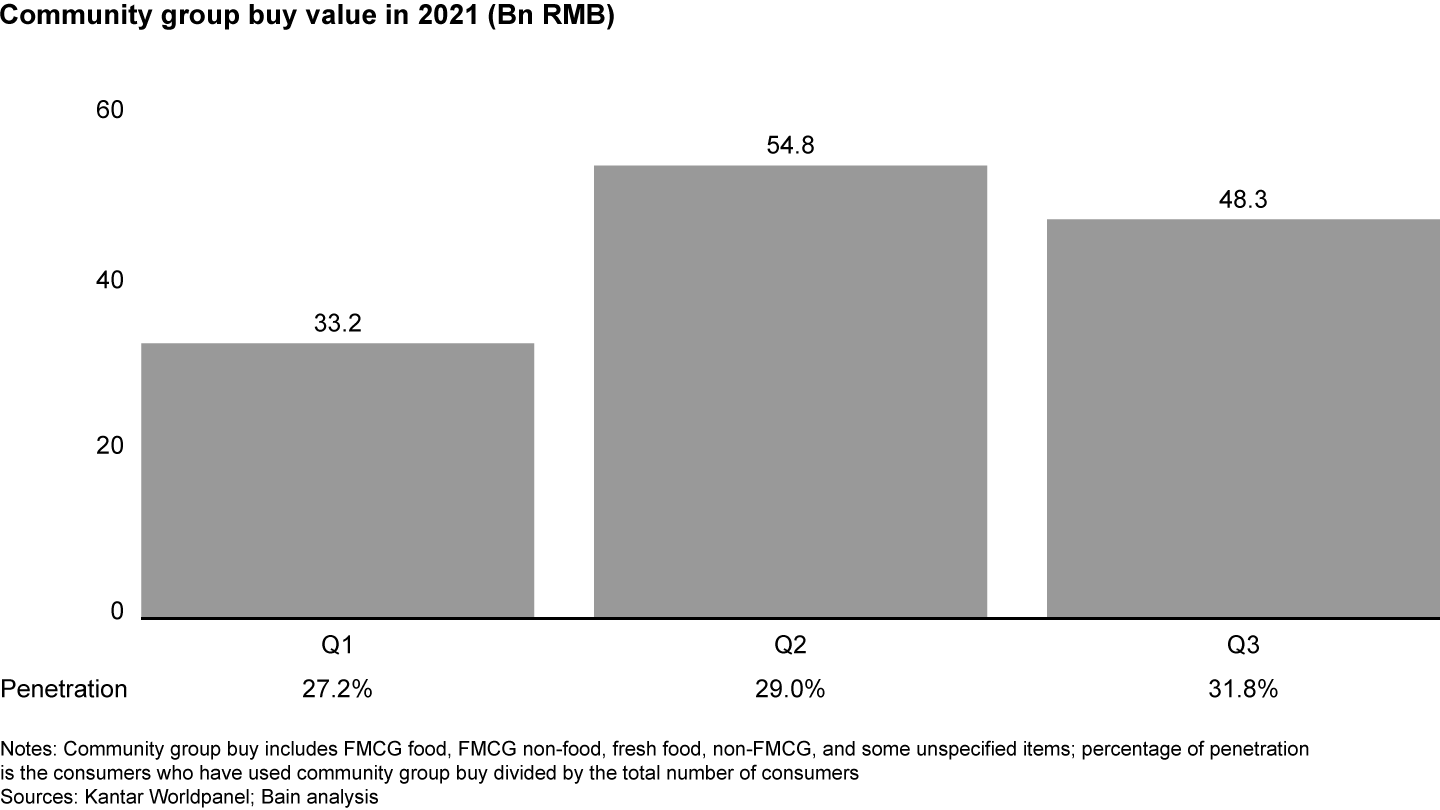
This model of paying to attract users proved unsustainable, and some platforms left the market or consolidated. Some went bankrupt. At the same time, many brands worried that community group buying would destroy pricing models on traditional channels. Another major concern: The government imposed stricter regulations to standardize the rules of the game to avoid goods-dumping issues.
To address these pain points, Alibaba developed a new economic model. Instead of relying on third-party wholesalers and distributors, the company now uses a pool of suppliers from the Alibaba group. It replaced pickup spots in individual homes with stores connected to Alibaba’s data analytics. The new model also replaces part-time group captains with full-time professionals hired by Alibaba, and it enables consumers to access the group buy via the front page of the Taobao app, thus leveraging the huge traffic in the Alibaba ecosystem (see Figure 9). By integrating all of its ecosystem players, the platform attempts to achieve higher ROI, deliver better service, and improve its product success rate.
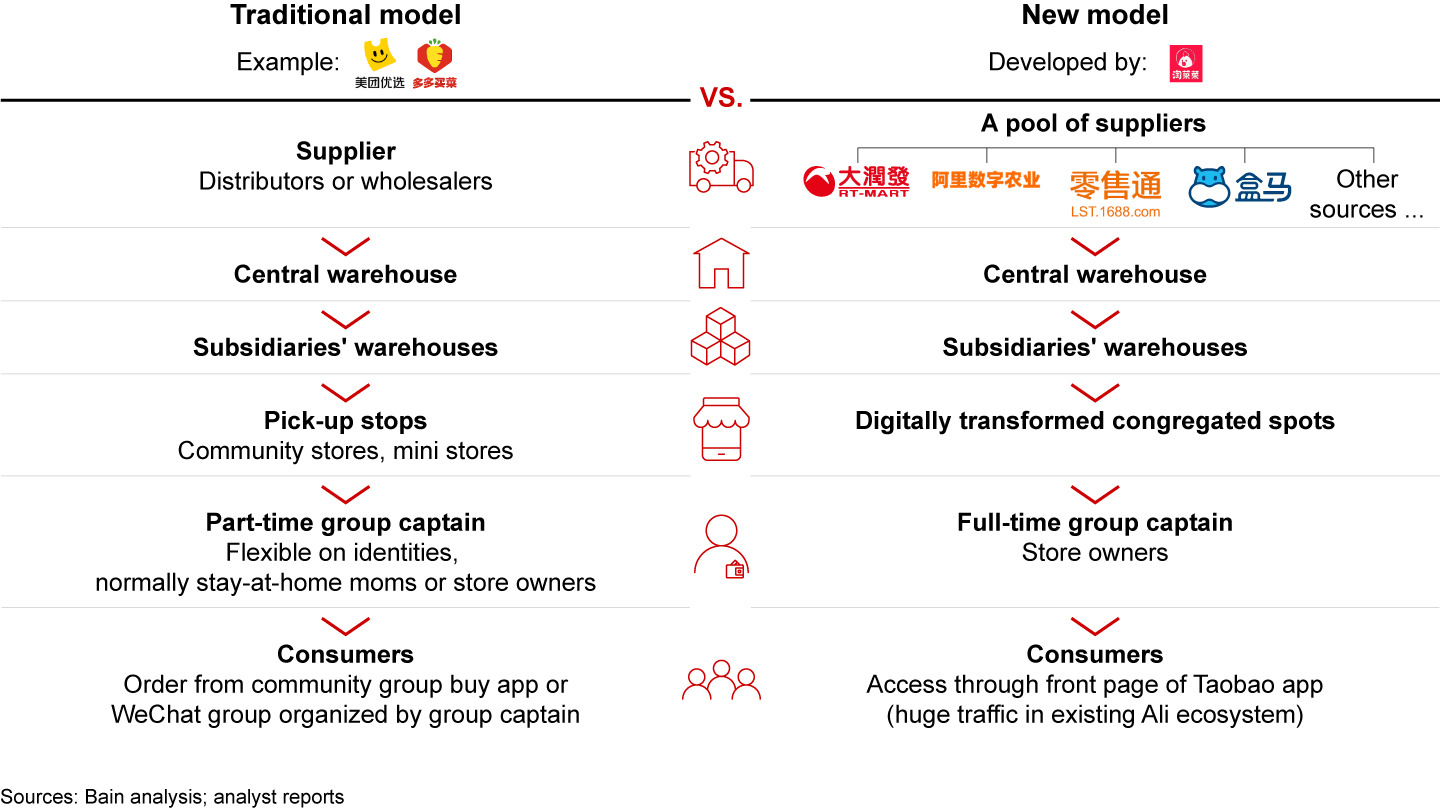
Insurgents: Win fast or fail fast
No place on earth can match China for speed, including the speed at which brands enter and exit the market—that pace is frightening. Consider that 30% of 2016’s makeup brands no longer exist and 40% of current makeup brands are less than five years old (see Figure 10). Also consider that 12% of 2016’s skin care brands disappeared and 35% of current skin care brands were added in the past five years.
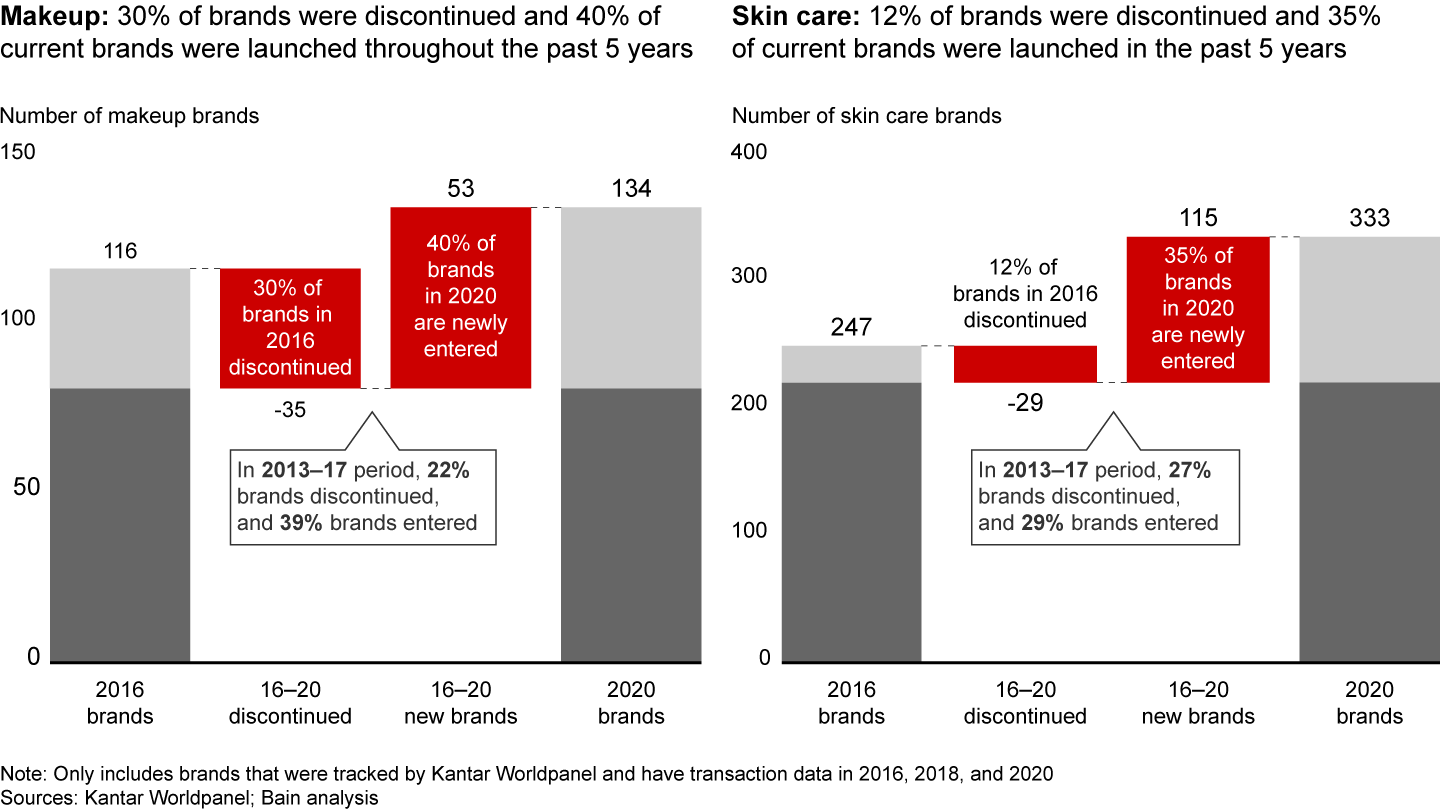
China’s win-fast/fail-fast FMCG culture is most evident among insurgent brands, which we began tracking in our China Shopper Report 2018, Vol. 2. For that research, we analyzed the performance of 46 local FMCG insurgent brands. We’ll call them the Class of 2018 (see Figure 11). These are both independent brands and brands under conglomerates, but with distinct business effort, that grew their 2015–2017 brand retail value by more than 10% while also outgrowing their category.
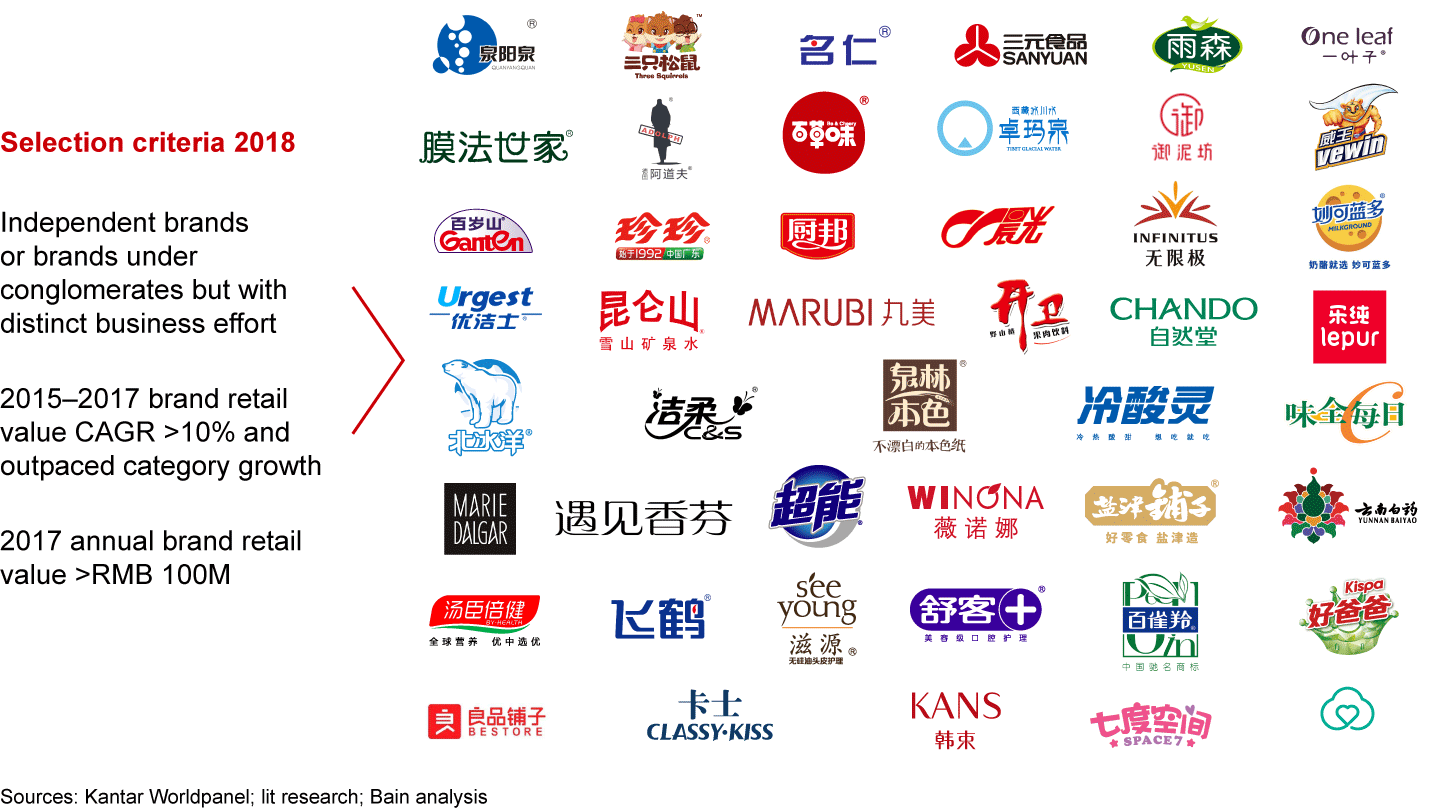
While half of the selected insurgent brands had annual (urban) retail value of RMB 100–500 million, they were growing phenomenally fast. Sixty-seven percent of them grew at least two times faster than their category average. While they only represented roughly 6% market share across the 33 categories they disrupted, these brands delivered nearly 20% of the category value growth in the two years before we started closely monitoring them across a range of dimensions.
How did the Class of 2018 do over the last three years? What can we learn from it?
After three years, some of these insurgents smoothly evolved from seed to scale to growth stage, while others stagnated or faded away from the market. We grouped them into three buckets based on the sales performance since 2018 of the 43 out of 46 brands continuously tracked by Kantar Worldpanel:
- Standouts are brands that saw their retail sales value grow by more than 10% annually from 2018 through 2020, outpacing their category. This group includes 17 brands, such as Milkground and Winona.
- Holdouts saw annual growth of less than 0% but outgrew their category or achieved annual growth in the 0% to 10% range; or they grew by more than 10% but failed to outgrow their category. Saky and Bei Bing Yang are among the nine members of this group.
- Fadeouts are those that failed to grow from 2018 through 2020 and underperformed their category. The 17 insurgents in this group included Marie Dalgar and Kans.
Digging deeper into their performance, we identified the moves that contributed to an insurgent’s success or caused its failure. It came down to four critical dimensions, and an insurgent needed to excel across the majority of the four to become a standout (see Figure 12). These are the spiked capabilities that underpinned success:
- Brand power: Was the insurgent able to use its brand to earn share of mind with the target consumer group and scale that group? Did it generate strong loyalty and advocacy among consumers?
- Product ecosystem: Did the brand successfully build superhero SKUs and extend from the core to establish a winning portfolio? What was the rate of success for new products?
- Channel capability: Could the insurgent develop an omnichannel presence and extensive geographic reach, empowered by digital tools, that allowed it to go deeper and wider? Could it maintain a stable pricing system across channels?
- Organization capability: Was the insurgent able to build agile iterative capabilities, empowered by data, to constantly review and improve its product development, channel expansion, and business model?
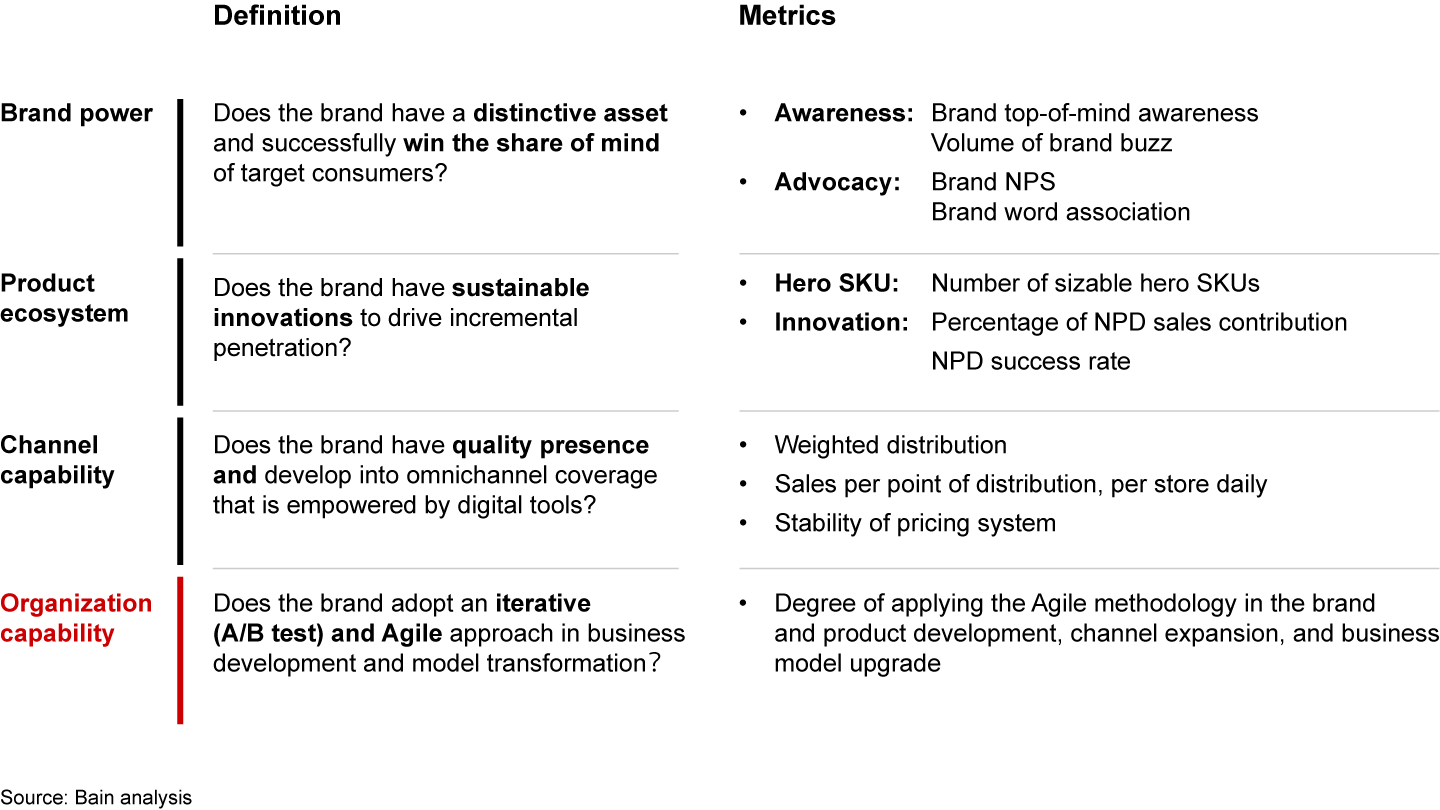
The experience of three different Class of 2018 insurgents shows how these critical capabilities—or the lack of them—translated into a wide range of business results.
By every measure, Milkground is an exceptional insurgent success—and a standout in our grouping. Founded in 2001, the dairy products company has grown at an annual rate of 112% since 2018. That success is due in large part to the company’s ability to introduce and thoughtfully extend a strong SKU. Milkground gave birth to the cheese stick category in China, when it launched a cheese stick snack for kids. From there, it expanded into cheese stick varieties for adults and diversified occasions like home cooking and restaurants. The insurgent developed a memorable brand message that it promoted on a few targeted channels. It pursued both online and offline, developing a network of 300,000 physical points of sale as it expanded its e-commerce presence into emerging channels like O2O and livestreaming.
Another success story is Winona. A local skin care brand founded in 2010, it excelled quickly with a facial moisturizing cream containing herbal ingredients. Winona sharpened its brand positioning to target consumers with sensitive skin and built out a full product line with add-on functions like treatments for oily skin. Professional marketing in the medical channel plays an important role in Winona’s success. For example, by partnering with leading dermatology institutions, Winona has built deep connections with dermatologist KOLs for brand advocacy across a range of consumer touchpoints. In addition to traditional online and offline retail channels, Winona is the only skin care brand marketed in public hospitals. It is now available in 30%–40% of public hospital dermatology departments.
To build on our lessons from those 46 Chinese insurgents, we have begun conducting a similar—and extensive—study of a new collection of representative insurgent brands across more than 40 categories, ranging from dairy company Adopt A Cow to baby snack insurgent Little Freddie to skin care’s Little Dream Garden. Our “Class of 2021” insurgents include 69 FMCG players that we will follow in the years ahead, taking a slightly different approach (see Figure 13). For example, we have introduced an upper limit to the required brand retail value (RMB 1 billion) and will add data from online sales, the source of the bulk of revenues for most insurgents. We’ve also included insurgent brands owned by major incumbents, such as ABI’s Blue Girl Beer and L’Oréal’s 3CE makeup brand. It is interesting to note that the Class of 2021 has more than a dozen brands owned by international companies and large local companies, a positive sign that these insurgent brands can be seeded and nurtured within larger corporations.
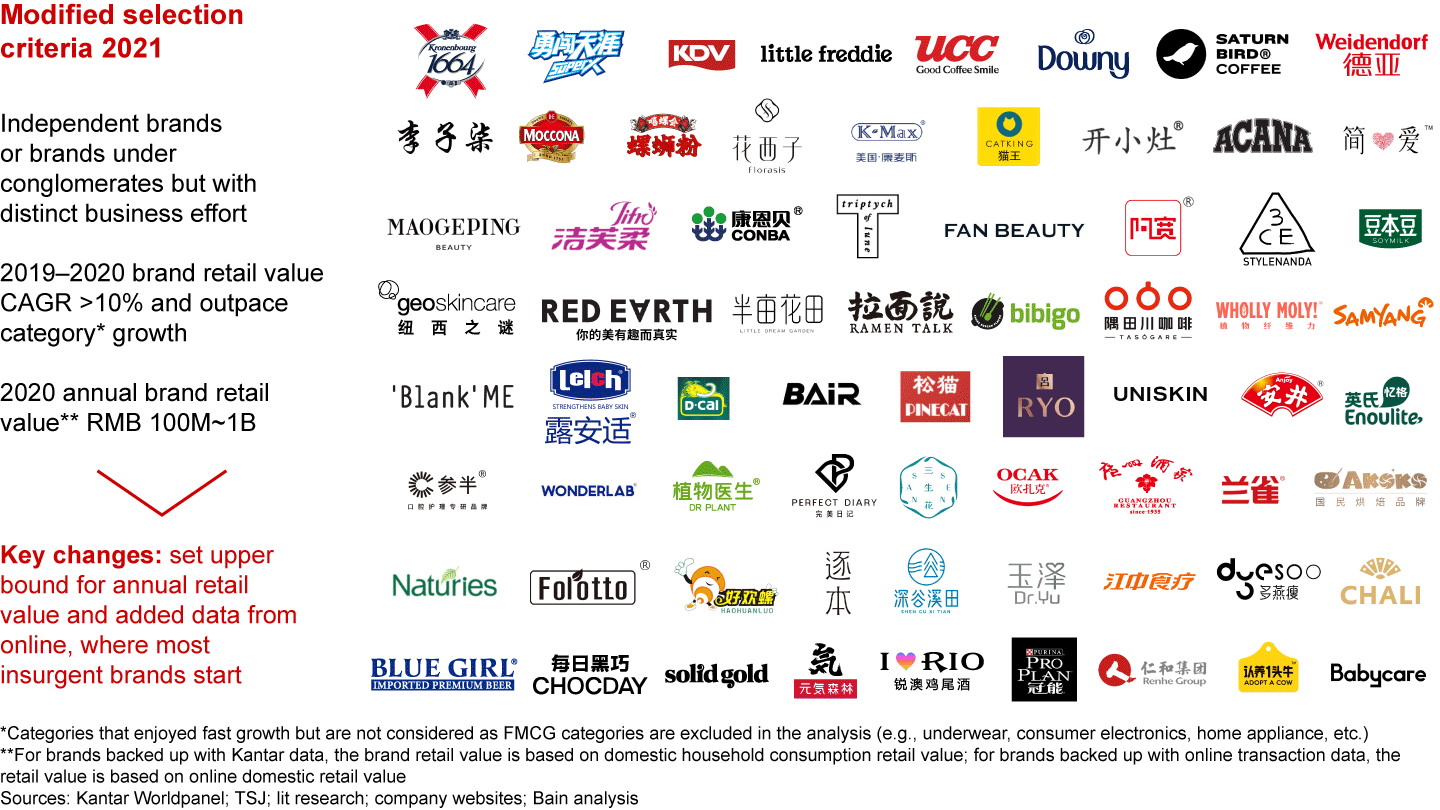
The 69 insurgent brands in our new research can generally be categorized into three distinct groups:
- Start from scratch brands are those in which an insurgent invented the brand and product from day one, and they still operate independently.
- Introduced by incumbents. Incumbent either incubated, acquired, or imported the brands.
- Crawling for a long time and then flying brands existed in the market at a small scale for a long time before suddenly growing by riding a trend.
Across these groups, insurgent brands continue to take an oversized share of the growth. Overall, they represent only 3% of market share but contribute 40% of value growth in the categories in which they compete (see Figure 14).2
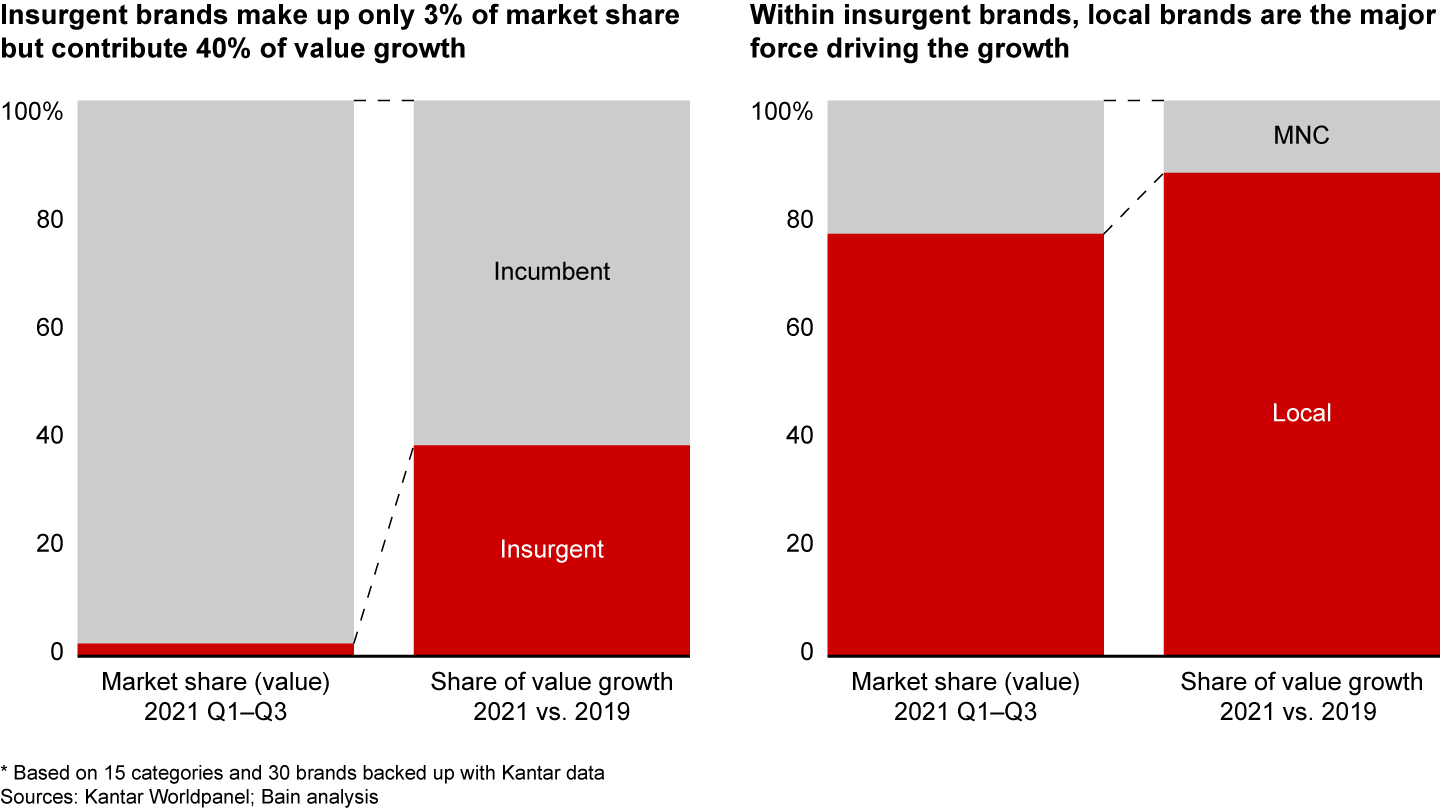
However, the rate at which insurgents erode incumbent market share varies dramatically by product category. Insurgents have captured more share in carbonated soft drinks than in beer, for example. In general, insurgent brands stand out in categories that are characterized by repertoire behavior, in which they have well-established upstream solutions with original design manufacturers or original equipment manufacturers and are less reliant on heavy asset investments—as there are in offline channels. Other important ingredients that turbocharge insurgent brands’ growth are “star” entrepreneurs and capital injections.
In China, local insurgents are far more powerful than multinational insurgents in both market share and their share of value growth. The data is impressive: Chinese insurgents claim about 80% of the market share and 90% of the value growth among insurgents.
As we track insurgent performance, we continually generate critical insights. For example, today’s insurgents are likely to take identifiable market positions by pursuing opposite pricing strategies—either premium or value for money (see Figure 15). It’s a strategy that’s even more pronounced among local insurgents. The polar pricing approach is a trait that distinguishes these brands from their “older” counterparts in the Class of 2018, whose price tiers were distributed more evenly.
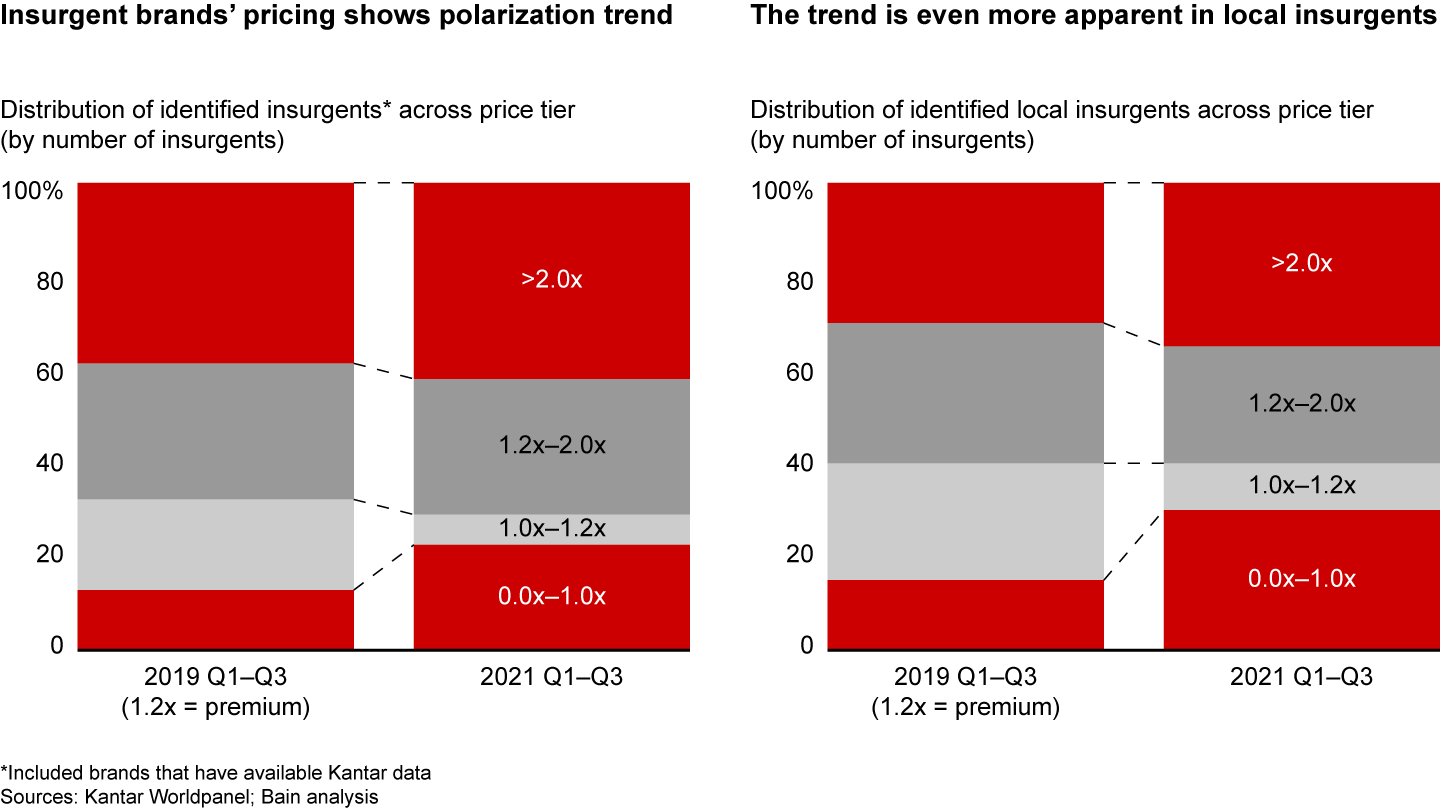
Also, because most insurgents were born in the digital era, they tend to be digital and data savvy, which has enabled them to thrive in online channels. Insurgents outpace incumbents in the online share of their business (see Figure 16). Although incumbents dedicate themselves to aggressively playing catch-up, insurgents are still more competitive online, and that gap is steadily widening.
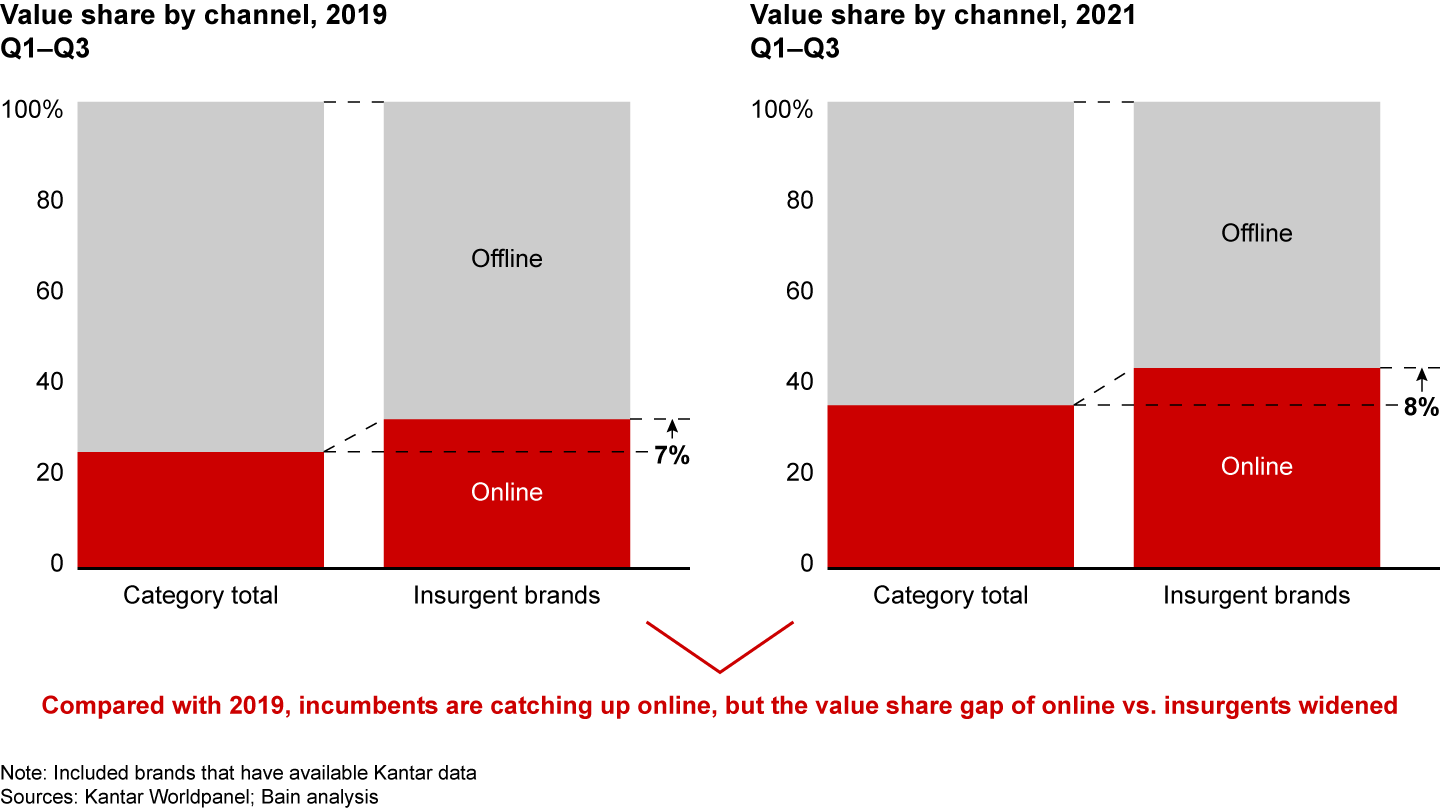
Implications
In this dynamic FMCG market, change is the only constant. Quality growth around these four pillars is critical today for both insurgents and incumbents:
- Brand power: Earn share of mind with the target consumer group, and scale that group
- Product ecosystem: Build superhero SKUs and extend from the core to establish a winning portfolio and a pipeline of innovations
- Channel capability: Develop a consumer-centric, omnichannel presence and extensive geographic reach, empowered by digital tools, to go deeper and wider
- Organization capability: Build agile iterative capabilities (empowered by data and insights) to constantly review and improve product development, channel expansion, and business model
In the end, what matters to consumers are brands that can deliver against these four pillars, whether insurgents or incumbents. Both forms of companies will always co-exist in China’s FMCG market and contribute in their own ways. The best companies will learn from each other and thrive together.
Incumbents can learn the nimble and agile approach developed by insurgents. They can develop the “fail fast and learn fast” mindset, not hesitating to get real feedback from the market and iterating along the way. Also, they can embrace new routines, with rounds of A/B testing in new product development instead of using the traditional “stage-and-gate” approach. Finally, they can be bolder and more creative in how they think about their organization, for example, assembling SWAT teams that consist of cross-functional employees to drive innovation instead of organizing and optimizing by vertical function.
Insurgent brands aiming to advance to the next level will need to grow in scale and with capabilities that can be replicated, something that incumbents, especially multinationals, have mastered. Insurgents can learn how to replicate the holistic brand building and scalable channel management capability that is critical to incumbents’ success. They can achieve this by building distinctive emotional connections rooted in the mindset of consumers. Insurgents also can develop a brand-management framework/system to guide the communication consistently in different media platforms. A final lesson that insurgents can learn from incumbents: how to carefully consider the trade-offs and select the right model for offline operations. This historically has been neglected by many insurgents as they underestimated the different requirements of running a business online and offline.
The China FMCG market will flourish from this cross-fertilization between incumbents and insurgents, and as a result, these two groups will bring more possibilities and excitement to Chinese consumers than either could on their own.

Kantar—Understand People, Inspire Growth
As part of Kantar, the world’s leading marketing data and analytics company, Worldpanel provides brands and retailers with a unique, 360-degree understanding of consumer behaviour across the globe. We are shopper-centric, continuously monitoring the purchase and usage behaviour through the largest omnipanel in the world to shape the brands of tomorrow by better understanding people everywhere. With unparalleled datasets, pioneering technology and expert analysts, we partner with brands and retailers of all sizes, empowering them to reimagine what’s possible, and change the landscape to create a better, healthier, more sustainable and inclusive world. In the China market, the Worldpanel division is one of the services in CTR, covering over 100 FMCG categories, 50,000+ brands and 100+ retailers, among many others.
Notes
- These 26 categories are (a) packaged food: biscuits, chocolate, instant noodles, candy, chewing gum, and infant formula; (b) beverages: milk, yogurt, juice, beer, ready-to-drink tea, carbonated soft drinks, and packaged water; (c) personal care: skin care, shampoo, personal wash, toothpaste, makeup, hair conditioner, diapers, and toothbrushes; and (d) home care: toilet tissue, laundry detergent, facial tissue, kitchen cleanser, and fabric softener.
- The data is based on the sales performance of all of the FMCG brands that meet the insurgents' selection criteria and are also tracked by the Kantar Worldpanel database.















